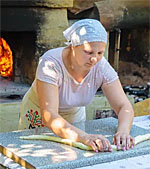Spanish Capital of Gastronomy for 2013
 Special to Road Trips for Foodies
Special to Road Trips for Foodies
By the Tourist Office of Spain
Burgos has been named the Spanish Capital of Gastronomy in 2013.
The honor was conferred by a panel formed of 11 personalities from the world of gastronomy and tourism. This initiative, organized by the Federación Española de Hostelería (FEHR) [Spanish Federation of Hospitality] and the Federación Española de Periodistas y Escritores de Turismo (FEPET) [Spanish Federation of Tourism Journalists and Writers], arose in 2011 with the aim of promoting gastronomy, at a national and at an international level, as one of the principal attractions for tourism in Spain.
Why has Burgos been appointed the Spanish Capital of Gastronomy in 2013?
According to the panel of the Spanish Capital of Gastronomy 2013, the project of the city of Burgos is “magnificent and excellent”. Its five keys are: the quality of its wines, of its chefs, of its products, the biodiversity of its territory and its creativity. Yes, all well-seasoned, of course. Over the coming year, more than 40 gastronomic initiatives will transmit a clear message: in Burgos you eat very, but really, very well, with extraordinary products coupled with wines recognized throughout the world, and all of that wrapped up in the finest gift paper, an historic and modern city where beauty is everywhere to be seen.
Burgos, the temple of wine
A few weeks ago, that glamorous phrase “and… the winner is” was heard from the United States and, then, “Ribera del Duero, Spain”. The Ribera del Duero had just been nominated ‘Wine region of the Year 2012’ by the Wine Stars Awards panel or the prizes considered the Oscars of the world of wine. Ribera del Duero triumphed over the Napa Valley (USA), the Cape Winelands (South Africa), the Walla Walla Valley (USA) and the Valley of the Loire (France). The decision has something to do with a way of working, of contemplating wine, in short, because of the “historic and traditional method of extracting the best expression of the Tempranillo grape”.
A total of 76% of vines in the Ribera del Duero are found in Burgos, in an area blessed by the Gods, where, for example, the most spectacular architecture of Norman Foster fits in perfectly with more traditional bodegas [wine cellars].
However, Burgos is not only the Ribera del Duero. It also has the Denomination of Origin Arlanza, which is found in a territory tempered in the history of Castile, from Covarrubias, passing through Silos, Lerma and Torquemada, and the sacred mysticism of a landscape swept by the north wind, which permit the elaboration of unique wines, generally by family winemakers.
Burgos is Culture
Burgos is a unique scenario, with a cultural heritage that invites us to live our experiences, such as the evolution of humankind at the Museum of Human Evolution and the exquisite perfection of Burgos Cathedral.
Burgos is Nature
The province of Burgos is, according to many experts, a place with great biodiversity, all of which because of its strongly contrasting features. Its micro-climates and ecosystems generate the most varied, delicate, and healthy raw materials.
Burgos is Travel
Thanks to its strategic location, Burgos has always been a staging point and a place where long journeys have been devised. It is a territory linked to heroic adventure, inner contemplation, and convivial life. The Camino de Santiago [Pilgrims Way of Saint James] passes through the province of Burgos along 114 kilometers. Burgos is located 245 km (153.1 miles) north of Madrid, around 2 ½ h by car or by train.
For more information on traveling in Spain, go online.


















